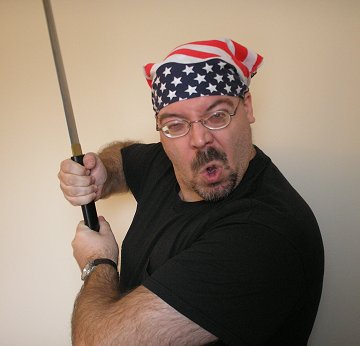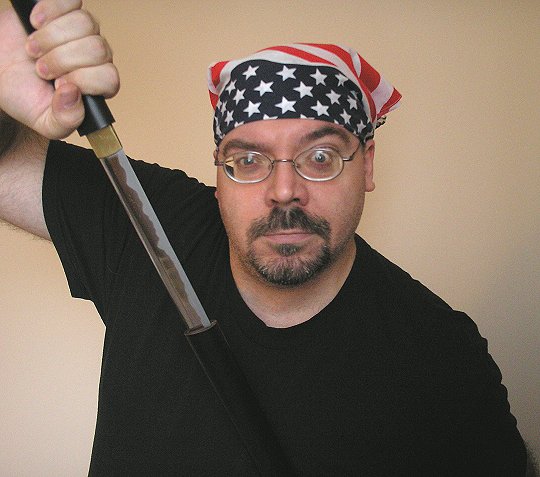It is a curious sensation to enjoy immensely the work of an author with whom you often disagree. This is the emotion I experience most frequently when reading anything by Dave Lowry, whose columns for Black Belt magazine have been collected in multiple bound volumes. Lowry is a traditionalist. Lowry is, in fact, an unabashed, avowed traditionalist who makes no excuses and no apologies for the elitist attitudes found within traditionally founded, traditionally practiced, traditionally expressed martial arts. Well spoken, thoughtful, and entertaining, Mr. Lowry expresses, eloquently and often, the elitist sentiments that have rendered so much of traditional martial art irrelevant to contemporary self-defense.
On 4 December, 2005, at a discussion site devoted to traditional Japanese martial arts, Mr. Lowry posted an entry titled, Worst Keikogi—An Aside. His post was in reaction to a recent discussion of the worst martial arts uniforms and poses the participants could find across the Internet. The posting of pictures from other martial artists’ websites, in order to ridicule the myriad sins committed by the models, is a popular and recurring topic at the site in question. A cynical observer might comment that such an activity is the most popular pastime at this particular site; it certainly seems to draw an incredible amount of attention from martial artists eager to point out everything from mistakes of technique to transgressions of fashion.
Certainly on the Internet there is no shortage of martial artists (would-be and otherwise) posing and posturing ridiculously. There is nothing wrong with pointing out egregious violations of technique or even of poking fun at outlandish costumes and displays. When ridiculing anyone and everyone who is not standing solemnly in a snow-white uniform, adhering to the strictest rigors of traditional decorum, becomes a purpose in and of itself, however, one’s approach to the martial arts flirts dangerously with irrelevance and petty
Mr. Lowry’s sneering contempt for all Westerners not conforming to his traditional notions of conduct and application is palpable in its scornful vehemence. He writes,
Still, wading through dazzling sartorial displays of those pinheaded congeners, the attention is arrested by the photo of Elvis—or “Ebbis” as he is more commonly known in the rustic climes of his most devoted followers.
It occurs that, well, there it is. The quintessential example of “American martial arts.” Has any one image ever summed it up more perfectly, more completely, more eloquently?
…Take away the mega-money and the grotesque, undiscerning attentions of his fans and you are left with one of a million of similar species: Homo vulgaris, the assorted Vinnies, Dwaynes, Ant’nys, and Bubbas who can be found hanging out in the parking lot at the 7-11, from Stumpwater, Alabama to the brownstone walkups of Brooklyn…A sad white trash apparition, desperately (and inappropriately) ashamed of his cornpone heritage, and so assuming a sense of exaggerated self-esteem, mistaking swagger for sophistication, sentiment for emotion, garish machismo for maturity.
So thoroughly Easternized is Mr. Lowry’s attitude that anything even hinting of the occidental in the martial arts is reason for fear and loathing. A man in a red-white-and-blue gi is not simply a Western practitioner of, say, Karate, whose commercial dojo has made concessions to Western culture and standards of value; he is, in the mind of Mr. Lowry, a vulgar and pathetic redneck who lacks the mental capacity and the depth of character to grasp the very, very important meaning of the traditional martial arts. Heaven help such a tobacco-chewing, professional-wrestling-t-shirt-wearing, NASCAR-watching bumpkin as he stumbles to the strip mall dojo in is silken and sequined uniform festooned with rank and weapons patches – for he is, at heart, not merely a backwards hick; he is the epitome of everything traditional martial artists deride. He is not in the club. He does not belong, and his heresy lies in his not belonging.
 One of Mr. Lowry’s Black Belt essays (which I read in one of the many collections of these that I own) discussed the fact that there are no observers’ chairs in traditional dojos. Visitors are not welcome and Mr. Lowry made no excuses for that. The student is, in fact, being done a favor by being taught. He should, in the mind of the traditional martial artist, be forever grateful for the great honor bestowed on him by his teacher.
One of Mr. Lowry’s Black Belt essays (which I read in one of the many collections of these that I own) discussed the fact that there are no observers’ chairs in traditional dojos. Visitors are not welcome and Mr. Lowry made no excuses for that. The student is, in fact, being done a favor by being taught. He should, in the mind of the traditional martial artist, be forever grateful for the great honor bestowed on him by his teacher.
This attitude contrasts sharply with Western morals and values. Westerners tend to see teachers as contractors – individuals paid to perform a service, whose mutual benefit is in being paid to do what they love. Westerners are less likely to take to the teacher-worship, the bowing and scraping, that characterize the most traditional of the traditional martial arts (which are primarily Eastern for purposes of this article). This is the occidental attitude of individualism, of self-worth, which Lowry sees as ringing so hollow, of being so false, in the mullet-upholstered minds of those he condescendingly dismisses as insecure, deluded yokels.
At the heart of this sharp divide – Eastern, traditional abasement of the individual in favor of conformity to ancient rules, ranks, customs, and structures – is what I believe is truly the cause for the rift. It is the reason so much of traditional martial art is irrelevant to self-defense. This is that Easternized practitioners of these stylized, technical, ritualistic pursuits see them as vehicles for self-discovery and transformation. They view them as traditions that exist in and of themselves, more important than a single individual and valuable as tradition, as a body of defined and preserved material that is worthy of being sustained unchanged indefinitely. They view any modification of these rituals and their content as cause for concern and for scorn. Worse, they see any departure from this body of motivations, mechanics, and mandates as heresy. One who moves outside, who becomes a heretic, has committed a fundamental sin. He does not belong – and his persistence in fields that could be considered martial, or which descend from that which he has forsaken, is an insult to those who believe he does not belong.
Opposed to the traditional martial arts are those who advocate pragmatic self-defense in some RBSD (Reality Based Self-Defense) format. Often such practitioners despise all tradition because they wrongly dismiss it all as unworkable or stylized. To such “thug-fu” practitioners, the term martial art is itself a dirty word, conjuring up point-sparring matches, strip-mall cardio kickboxing classes, and other things useless for preempting, meeting, and defeating real-life violence.
Both camps, in their most extreme incarnations, are missing the point. One of the reasons The Martialist manages to irk so many people is that it cannot be easily categorized by members of the opposed camps. I have studied traditional martial arts and taken much of value from them; I refuse to dismiss a technique or a method out of hand based on its traditional provenance. I see much of martial art as useful to pragmatic self-defense.
At the same time, I recognize much of the traditional martial arts – especially those characterized by elitist attitudes and the elevation of ritual over reality – as completely irrelevant to my pursuit of success in self-defense. Thus I have no traditional rankings or certifications that any of these people would find impressive – and I never hear the end of it from said individuals when I dare to criticize their snobbish attitudes or their utopian approaches. These are people who, at their worst, are practicing traditional arts that are completely unsuitable for the delivery of physical force in a real-life self-defense encounter. These are people who see the goals of self-discovery, of mental and emotional development, as the primary purpose of practicing such arts. This is like saying the primary purpose of driving a race car is learning to sit comfortably, to develop an appropriate appreciation for lumbar support. Somewhere in the intervening decades or centuries, the true purpose of the exercise has been lost.
Lowry as much as admits this in his screed against the uncouth and unclean trailer-dwellers against whom he rails:
[Elvis] is a trope, of sorts, for how many other pathetic losers, most of them less successful materially to be sure, but similarly acting out their fantasies of toughness and power? And of course, they’ve stumbled right into the karate dojo to embrace it all—even though the concept of karate as a transformative experience, as art, as ennobling, as a medium towards worthwhile social interaction and conflict is as foreign to them as calculus is to an ape…
…If he has studied at all, he has learned only superficialities. Nothing of the art has become integrated into his body…Mr. Presley is a glimpse inside the mentality of so many “martial artists” it’s depressing to think too much about it. Pretentious, affected, so oblivious as a result of their own self-obsession and their real and perceived shortcomings as adults they would not recognise real budo if [it] hit them between the eyes, they have, ironically, come to represent it. You and I laugh at these photos. We should. But we should remember that to a huge percentage of the general public, these fops and posers are martial arts.
There you have it – the source of Mr. Lowry’s displeasure and the crawling, spiny bug in the craw of every traditional Eastern martial artist who has ever snorted his disapproval of his more occidental contemporaries. These losers aren’t in the club, but the uninitiated will think they are, and this we cannot tolerate. It is an insult to our honor and our dignity. It is a violation of the sense of elitism with which we cloak ourselves – and that masks the very shortcomings of ego and skill we are so quick to identify in others. That is the attitude of the irrelevant traditionalists. That is their concern – membership in the clique above all else.

To a traditionalist, is there any worse imagery than a Westerner sporting American Flag regalia, abusing a poorly constructed katana replica? Zatoichi, at that!
Self-defense is the right of every human being – though the right to pursue it is not a guarantee of success. Self-defense is not the purview of only those with the plainest, most traditional uniforms. It is not the sole territory of only those whose liberal-progressive mindset leaves them to abhor and to jeer at Midwest America. Self-defense is not the exclusive domain of only those who’ve bowed and groveled at the feet of the smallest, most wrinkled, most silent of solemn Asian instructors. Self-defense is not a privilege granted by membership to a club or a clique.
When membership in your clique becomes more important than success in delivering physical force against determined and aggressive societal predators, what you do and what you practice has become irrelevant. Your traditionalist cliquery has subsumed your pursuit of whatever you thought you were accomplishing. It has rendered you helpless; it has drawn you as a bitter, angry, snobbish caricature more concerned with who’s “in” and who’s “out” than with who is safer and who is able. It has left you insecure and transparent, pointing and laughing at others from the safety of a mob because this bolsters the low self-esteem and lack of self-awareness you are so quick to see in those “greasy” Westerners who fail to meet your exacting standards.
It has left you impotent, your lip curled in disdain in a fashion that would do “Ebbis” proud.
—
For the opposite perspective, download the PDF file, Non-Traditionalist Cliquery and Self-Defense.